Applying Motivation Theories: School Teachers' Strategies for Students
VerifiedAdded on 2023/06/12
|7
|1913
|344
Essay
AI Summary
This essay explores the crucial role of motivation in education and how it influences student engagement and learning outcomes. It delves into motivation theories, particularly operant conditioning, which emphasizes the use of reinforcement and punishment to shape behavior. The essay highlights practical strategies that teachers can implement in the classroom, such as building relationships with students, using illustrative examples, leveraging technology, providing praise, and fostering creativity. It also underscores the importance of empowering students by giving them control over their learning and making data-driven decisions to cater to individual needs. The essay concludes that by understanding and applying these motivational strategies, teachers can create a more engaging and effective learning environment for their students. Desklib offers a wealth of similar resources and solved assignments for students seeking academic support.
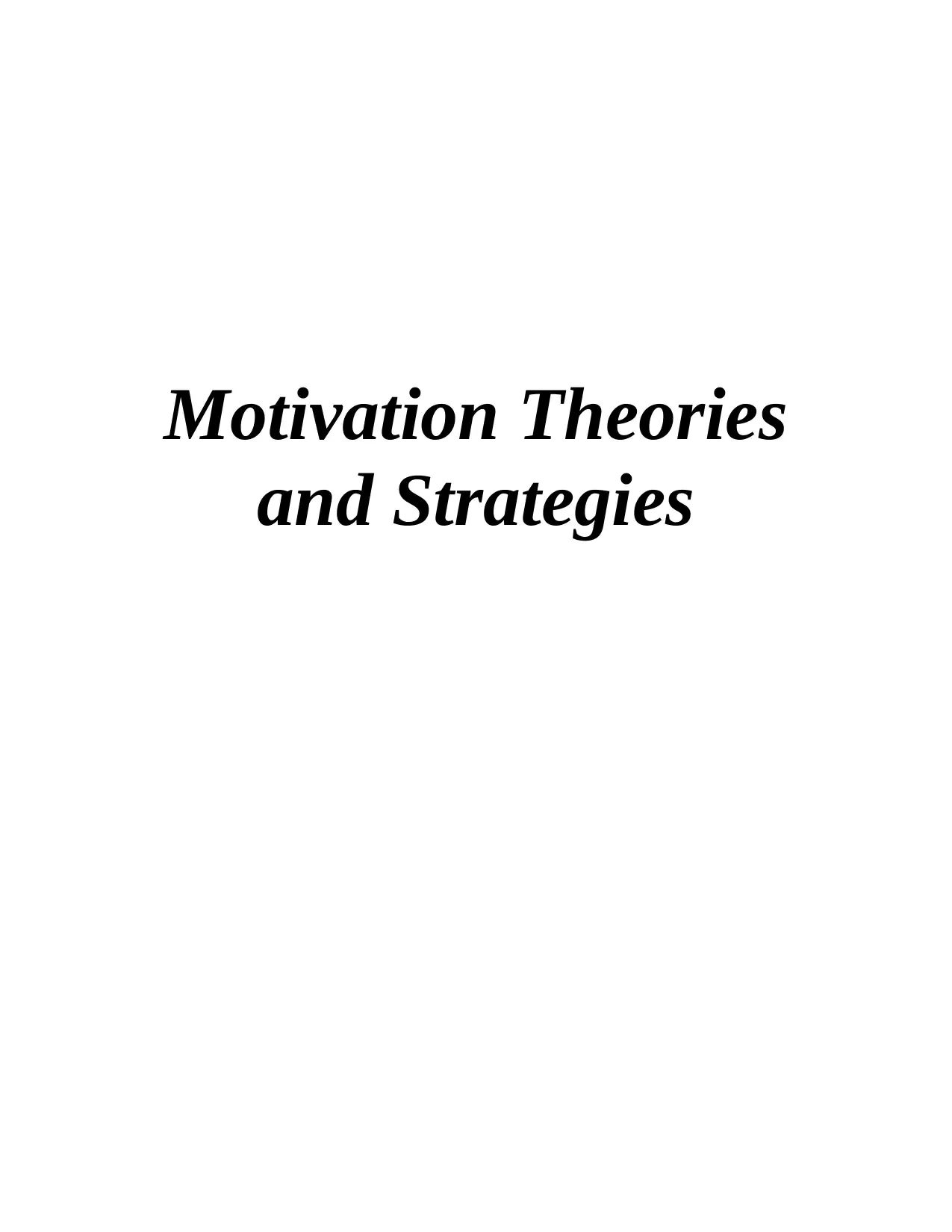
Motivation Theories
and Strategies
and Strategies
Paraphrase This Document
Need a fresh take? Get an instant paraphrase of this document with our AI Paraphraser
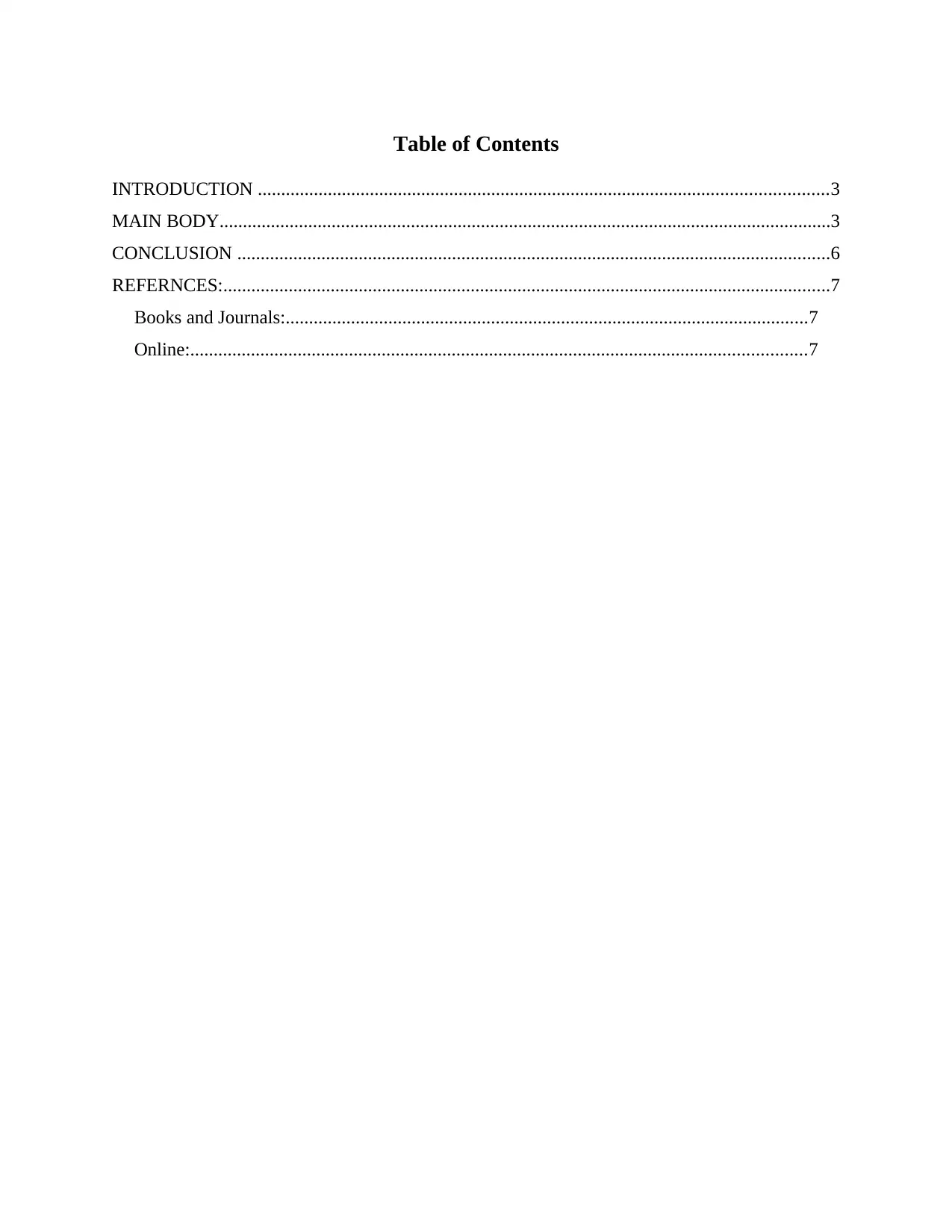
Table of Contents
INTRODUCTION ..........................................................................................................................3
MAIN BODY...................................................................................................................................3
CONCLUSION ...............................................................................................................................6
REFERNCES:..................................................................................................................................7
Books and Journals:................................................................................................................7
Online:....................................................................................................................................7
INTRODUCTION ..........................................................................................................................3
MAIN BODY...................................................................................................................................3
CONCLUSION ...............................................................................................................................6
REFERNCES:..................................................................................................................................7
Books and Journals:................................................................................................................7
Online:....................................................................................................................................7
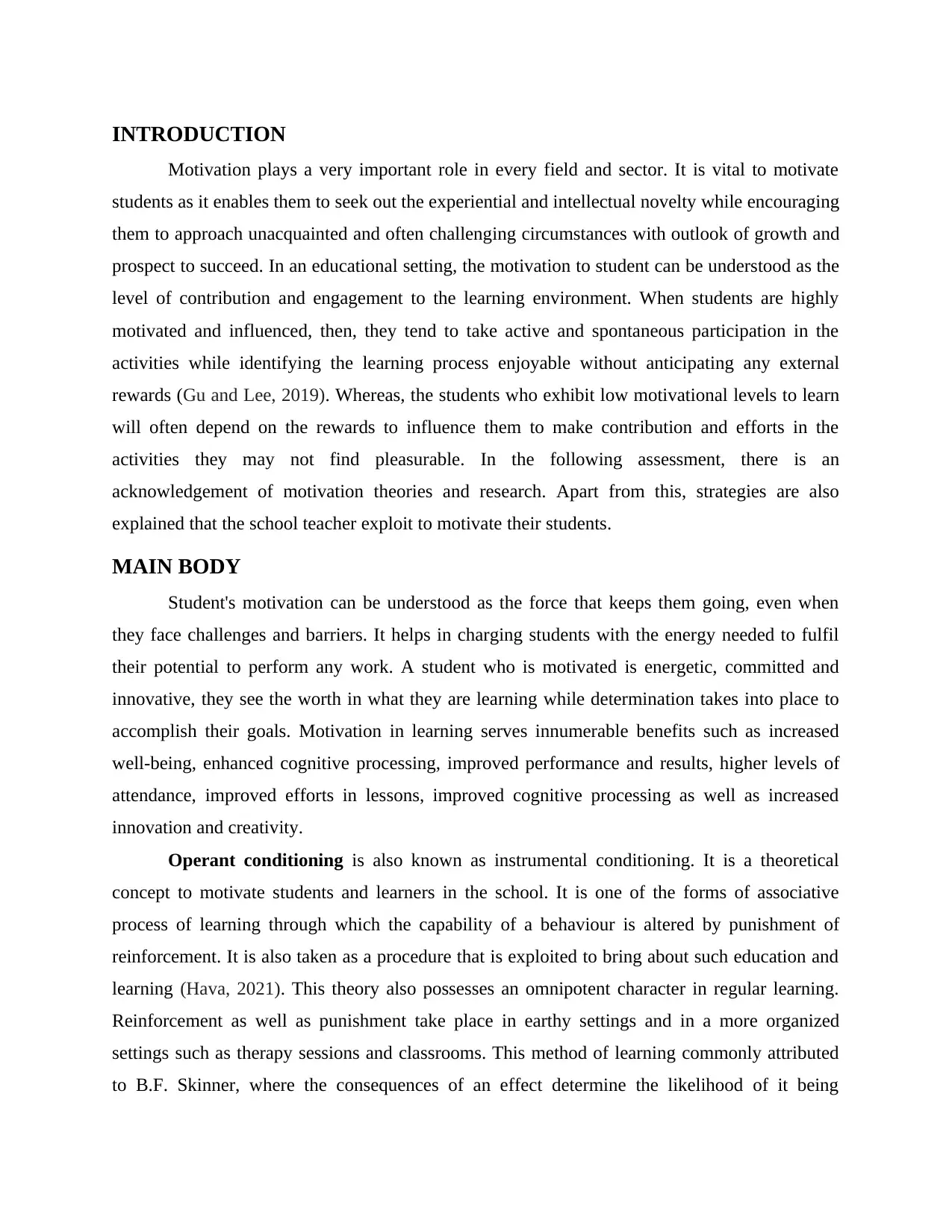
INTRODUCTION
Motivation plays a very important role in every field and sector. It is vital to motivate
students as it enables them to seek out the experiential and intellectual novelty while encouraging
them to approach unacquainted and often challenging circumstances with outlook of growth and
prospect to succeed. In an educational setting, the motivation to student can be understood as the
level of contribution and engagement to the learning environment. When students are highly
motivated and influenced, then, they tend to take active and spontaneous participation in the
activities while identifying the learning process enjoyable without anticipating any external
rewards (Gu and Lee, 2019). Whereas, the students who exhibit low motivational levels to learn
will often depend on the rewards to influence them to make contribution and efforts in the
activities they may not find pleasurable. In the following assessment, there is an
acknowledgement of motivation theories and research. Apart from this, strategies are also
explained that the school teacher exploit to motivate their students.
MAIN BODY
Student's motivation can be understood as the force that keeps them going, even when
they face challenges and barriers. It helps in charging students with the energy needed to fulfil
their potential to perform any work. A student who is motivated is energetic, committed and
innovative, they see the worth in what they are learning while determination takes into place to
accomplish their goals. Motivation in learning serves innumerable benefits such as increased
well-being, enhanced cognitive processing, improved performance and results, higher levels of
attendance, improved efforts in lessons, improved cognitive processing as well as increased
innovation and creativity.
Operant conditioning is also known as instrumental conditioning. It is a theoretical
concept to motivate students and learners in the school. It is one of the forms of associative
process of learning through which the capability of a behaviour is altered by punishment of
reinforcement. It is also taken as a procedure that is exploited to bring about such education and
learning (Hava, 2021). This theory also possesses an omnipotent character in regular learning.
Reinforcement as well as punishment take place in earthy settings and in a more organized
settings such as therapy sessions and classrooms. This method of learning commonly attributed
to B.F. Skinner, where the consequences of an effect determine the likelihood of it being
Motivation plays a very important role in every field and sector. It is vital to motivate
students as it enables them to seek out the experiential and intellectual novelty while encouraging
them to approach unacquainted and often challenging circumstances with outlook of growth and
prospect to succeed. In an educational setting, the motivation to student can be understood as the
level of contribution and engagement to the learning environment. When students are highly
motivated and influenced, then, they tend to take active and spontaneous participation in the
activities while identifying the learning process enjoyable without anticipating any external
rewards (Gu and Lee, 2019). Whereas, the students who exhibit low motivational levels to learn
will often depend on the rewards to influence them to make contribution and efforts in the
activities they may not find pleasurable. In the following assessment, there is an
acknowledgement of motivation theories and research. Apart from this, strategies are also
explained that the school teacher exploit to motivate their students.
MAIN BODY
Student's motivation can be understood as the force that keeps them going, even when
they face challenges and barriers. It helps in charging students with the energy needed to fulfil
their potential to perform any work. A student who is motivated is energetic, committed and
innovative, they see the worth in what they are learning while determination takes into place to
accomplish their goals. Motivation in learning serves innumerable benefits such as increased
well-being, enhanced cognitive processing, improved performance and results, higher levels of
attendance, improved efforts in lessons, improved cognitive processing as well as increased
innovation and creativity.
Operant conditioning is also known as instrumental conditioning. It is a theoretical
concept to motivate students and learners in the school. It is one of the forms of associative
process of learning through which the capability of a behaviour is altered by punishment of
reinforcement. It is also taken as a procedure that is exploited to bring about such education and
learning (Hava, 2021). This theory also possesses an omnipotent character in regular learning.
Reinforcement as well as punishment take place in earthy settings and in a more organized
settings such as therapy sessions and classrooms. This method of learning commonly attributed
to B.F. Skinner, where the consequences of an effect determine the likelihood of it being
⊘ This is a preview!⊘
Do you want full access?
Subscribe today to unlock all pages.

Trusted by 1+ million students worldwide
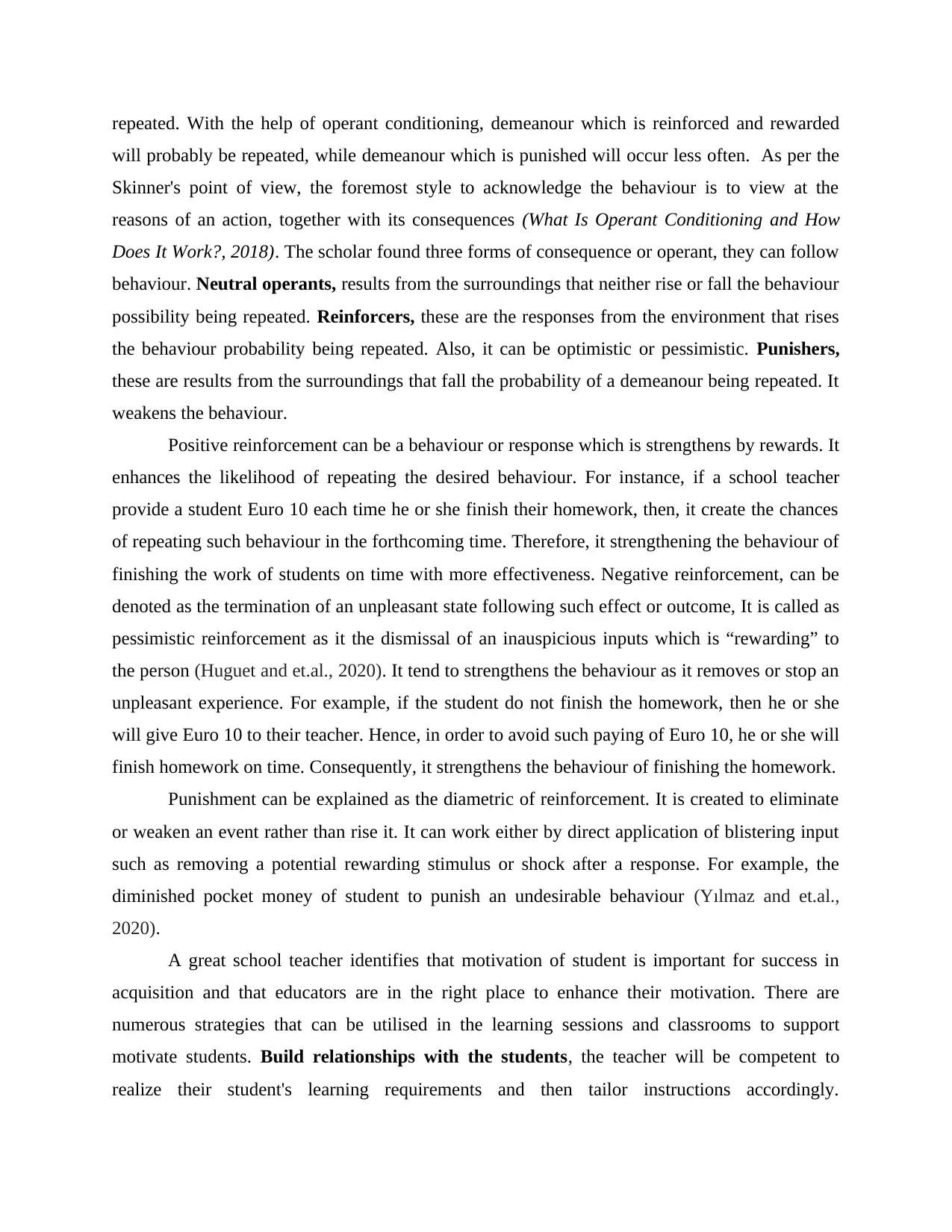
repeated. With the help of operant conditioning, demeanour which is reinforced and rewarded
will probably be repeated, while demeanour which is punished will occur less often. As per the
Skinner's point of view, the foremost style to acknowledge the behaviour is to view at the
reasons of an action, together with its consequences (What Is Operant Conditioning and How
Does It Work?, 2018). The scholar found three forms of consequence or operant, they can follow
behaviour. Neutral operants, results from the surroundings that neither rise or fall the behaviour
possibility being repeated. Reinforcers, these are the responses from the environment that rises
the behaviour probability being repeated. Also, it can be optimistic or pessimistic. Punishers,
these are results from the surroundings that fall the probability of a demeanour being repeated. It
weakens the behaviour.
Positive reinforcement can be a behaviour or response which is strengthens by rewards. It
enhances the likelihood of repeating the desired behaviour. For instance, if a school teacher
provide a student Euro 10 each time he or she finish their homework, then, it create the chances
of repeating such behaviour in the forthcoming time. Therefore, it strengthening the behaviour of
finishing the work of students on time with more effectiveness. Negative reinforcement, can be
denoted as the termination of an unpleasant state following such effect or outcome, It is called as
pessimistic reinforcement as it the dismissal of an inauspicious inputs which is “rewarding” to
the person (Huguet and et.al., 2020). It tend to strengthens the behaviour as it removes or stop an
unpleasant experience. For example, if the student do not finish the homework, then he or she
will give Euro 10 to their teacher. Hence, in order to avoid such paying of Euro 10, he or she will
finish homework on time. Consequently, it strengthens the behaviour of finishing the homework.
Punishment can be explained as the diametric of reinforcement. It is created to eliminate
or weaken an event rather than rise it. It can work either by direct application of blistering input
such as removing a potential rewarding stimulus or shock after a response. For example, the
diminished pocket money of student to punish an undesirable behaviour (Yılmaz and et.al.,
2020).
A great school teacher identifies that motivation of student is important for success in
acquisition and that educators are in the right place to enhance their motivation. There are
numerous strategies that can be utilised in the learning sessions and classrooms to support
motivate students. Build relationships with the students, the teacher will be competent to
realize their student's learning requirements and then tailor instructions accordingly.
will probably be repeated, while demeanour which is punished will occur less often. As per the
Skinner's point of view, the foremost style to acknowledge the behaviour is to view at the
reasons of an action, together with its consequences (What Is Operant Conditioning and How
Does It Work?, 2018). The scholar found three forms of consequence or operant, they can follow
behaviour. Neutral operants, results from the surroundings that neither rise or fall the behaviour
possibility being repeated. Reinforcers, these are the responses from the environment that rises
the behaviour probability being repeated. Also, it can be optimistic or pessimistic. Punishers,
these are results from the surroundings that fall the probability of a demeanour being repeated. It
weakens the behaviour.
Positive reinforcement can be a behaviour or response which is strengthens by rewards. It
enhances the likelihood of repeating the desired behaviour. For instance, if a school teacher
provide a student Euro 10 each time he or she finish their homework, then, it create the chances
of repeating such behaviour in the forthcoming time. Therefore, it strengthening the behaviour of
finishing the work of students on time with more effectiveness. Negative reinforcement, can be
denoted as the termination of an unpleasant state following such effect or outcome, It is called as
pessimistic reinforcement as it the dismissal of an inauspicious inputs which is “rewarding” to
the person (Huguet and et.al., 2020). It tend to strengthens the behaviour as it removes or stop an
unpleasant experience. For example, if the student do not finish the homework, then he or she
will give Euro 10 to their teacher. Hence, in order to avoid such paying of Euro 10, he or she will
finish homework on time. Consequently, it strengthens the behaviour of finishing the homework.
Punishment can be explained as the diametric of reinforcement. It is created to eliminate
or weaken an event rather than rise it. It can work either by direct application of blistering input
such as removing a potential rewarding stimulus or shock after a response. For example, the
diminished pocket money of student to punish an undesirable behaviour (Yılmaz and et.al.,
2020).
A great school teacher identifies that motivation of student is important for success in
acquisition and that educators are in the right place to enhance their motivation. There are
numerous strategies that can be utilised in the learning sessions and classrooms to support
motivate students. Build relationships with the students, the teacher will be competent to
realize their student's learning requirements and then tailor instructions accordingly.
Paraphrase This Document
Need a fresh take? Get an instant paraphrase of this document with our AI Paraphraser
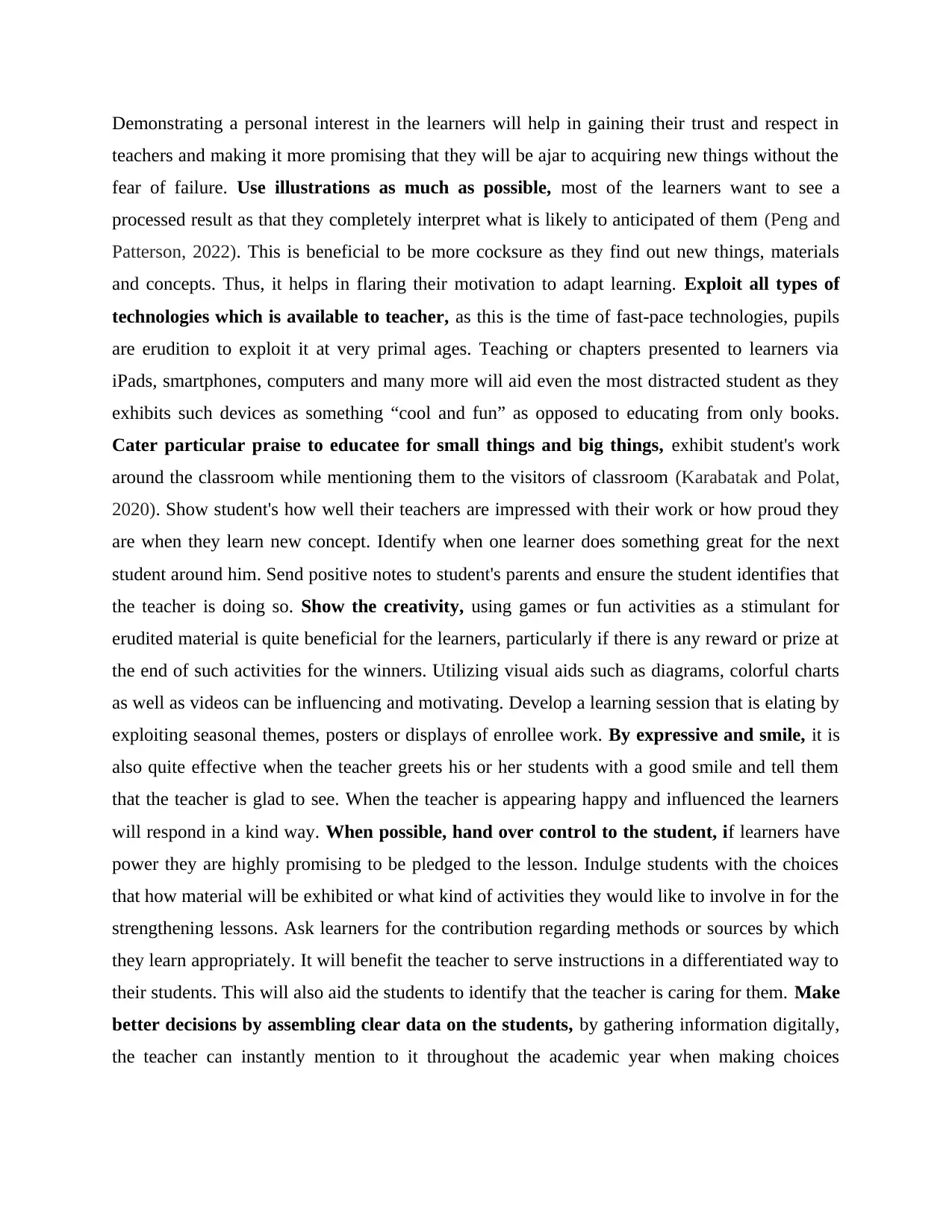
Demonstrating a personal interest in the learners will help in gaining their trust and respect in
teachers and making it more promising that they will be ajar to acquiring new things without the
fear of failure. Use illustrations as much as possible, most of the learners want to see a
processed result as that they completely interpret what is likely to anticipated of them (Peng and
Patterson, 2022). This is beneficial to be more cocksure as they find out new things, materials
and concepts. Thus, it helps in flaring their motivation to adapt learning. Exploit all types of
technologies which is available to teacher, as this is the time of fast-pace technologies, pupils
are erudition to exploit it at very primal ages. Teaching or chapters presented to learners via
iPads, smartphones, computers and many more will aid even the most distracted student as they
exhibits such devices as something “cool and fun” as opposed to educating from only books.
Cater particular praise to educatee for small things and big things, exhibit student's work
around the classroom while mentioning them to the visitors of classroom (Karabatak and Polat,
2020). Show student's how well their teachers are impressed with their work or how proud they
are when they learn new concept. Identify when one learner does something great for the next
student around him. Send positive notes to student's parents and ensure the student identifies that
the teacher is doing so. Show the creativity, using games or fun activities as a stimulant for
erudited material is quite beneficial for the learners, particularly if there is any reward or prize at
the end of such activities for the winners. Utilizing visual aids such as diagrams, colorful charts
as well as videos can be influencing and motivating. Develop a learning session that is elating by
exploiting seasonal themes, posters or displays of enrollee work. By expressive and smile, it is
also quite effective when the teacher greets his or her students with a good smile and tell them
that the teacher is glad to see. When the teacher is appearing happy and influenced the learners
will respond in a kind way. When possible, hand over control to the student, if learners have
power they are highly promising to be pledged to the lesson. Indulge students with the choices
that how material will be exhibited or what kind of activities they would like to involve in for the
strengthening lessons. Ask learners for the contribution regarding methods or sources by which
they learn appropriately. It will benefit the teacher to serve instructions in a differentiated way to
their students. This will also aid the students to identify that the teacher is caring for them. Make
better decisions by assembling clear data on the students, by gathering information digitally,
the teacher can instantly mention to it throughout the academic year when making choices
teachers and making it more promising that they will be ajar to acquiring new things without the
fear of failure. Use illustrations as much as possible, most of the learners want to see a
processed result as that they completely interpret what is likely to anticipated of them (Peng and
Patterson, 2022). This is beneficial to be more cocksure as they find out new things, materials
and concepts. Thus, it helps in flaring their motivation to adapt learning. Exploit all types of
technologies which is available to teacher, as this is the time of fast-pace technologies, pupils
are erudition to exploit it at very primal ages. Teaching or chapters presented to learners via
iPads, smartphones, computers and many more will aid even the most distracted student as they
exhibits such devices as something “cool and fun” as opposed to educating from only books.
Cater particular praise to educatee for small things and big things, exhibit student's work
around the classroom while mentioning them to the visitors of classroom (Karabatak and Polat,
2020). Show student's how well their teachers are impressed with their work or how proud they
are when they learn new concept. Identify when one learner does something great for the next
student around him. Send positive notes to student's parents and ensure the student identifies that
the teacher is doing so. Show the creativity, using games or fun activities as a stimulant for
erudited material is quite beneficial for the learners, particularly if there is any reward or prize at
the end of such activities for the winners. Utilizing visual aids such as diagrams, colorful charts
as well as videos can be influencing and motivating. Develop a learning session that is elating by
exploiting seasonal themes, posters or displays of enrollee work. By expressive and smile, it is
also quite effective when the teacher greets his or her students with a good smile and tell them
that the teacher is glad to see. When the teacher is appearing happy and influenced the learners
will respond in a kind way. When possible, hand over control to the student, if learners have
power they are highly promising to be pledged to the lesson. Indulge students with the choices
that how material will be exhibited or what kind of activities they would like to involve in for the
strengthening lessons. Ask learners for the contribution regarding methods or sources by which
they learn appropriately. It will benefit the teacher to serve instructions in a differentiated way to
their students. This will also aid the students to identify that the teacher is caring for them. Make
better decisions by assembling clear data on the students, by gathering information digitally,
the teacher can instantly mention to it throughout the academic year when making choices
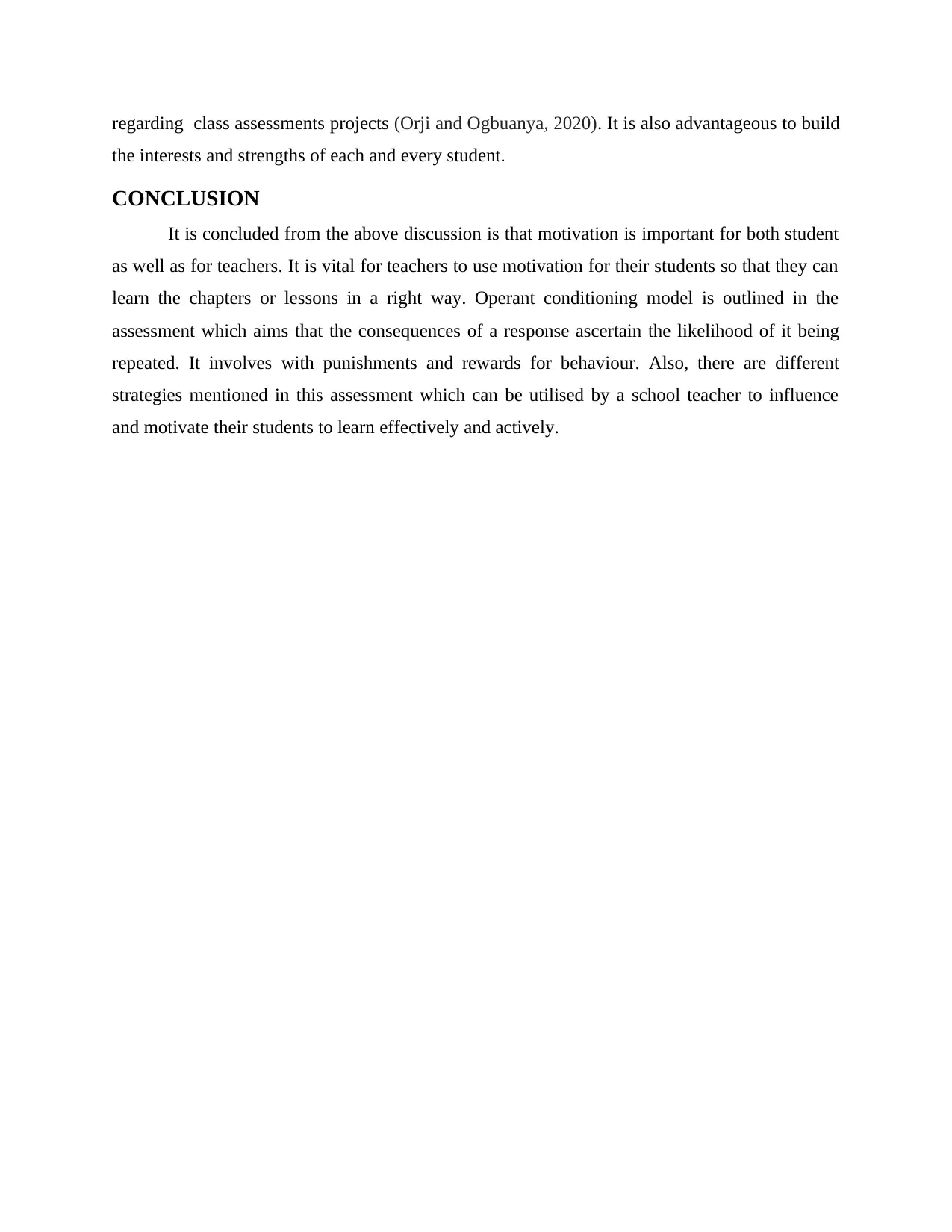
regarding class assessments projects (Orji and Ogbuanya, 2020). It is also advantageous to build
the interests and strengths of each and every student.
CONCLUSION
It is concluded from the above discussion is that motivation is important for both student
as well as for teachers. It is vital for teachers to use motivation for their students so that they can
learn the chapters or lessons in a right way. Operant conditioning model is outlined in the
assessment which aims that the consequences of a response ascertain the likelihood of it being
repeated. It involves with punishments and rewards for behaviour. Also, there are different
strategies mentioned in this assessment which can be utilised by a school teacher to influence
and motivate their students to learn effectively and actively.
the interests and strengths of each and every student.
CONCLUSION
It is concluded from the above discussion is that motivation is important for both student
as well as for teachers. It is vital for teachers to use motivation for their students so that they can
learn the chapters or lessons in a right way. Operant conditioning model is outlined in the
assessment which aims that the consequences of a response ascertain the likelihood of it being
repeated. It involves with punishments and rewards for behaviour. Also, there are different
strategies mentioned in this assessment which can be utilised by a school teacher to influence
and motivate their students to learn effectively and actively.
⊘ This is a preview!⊘
Do you want full access?
Subscribe today to unlock all pages.

Trusted by 1+ million students worldwide
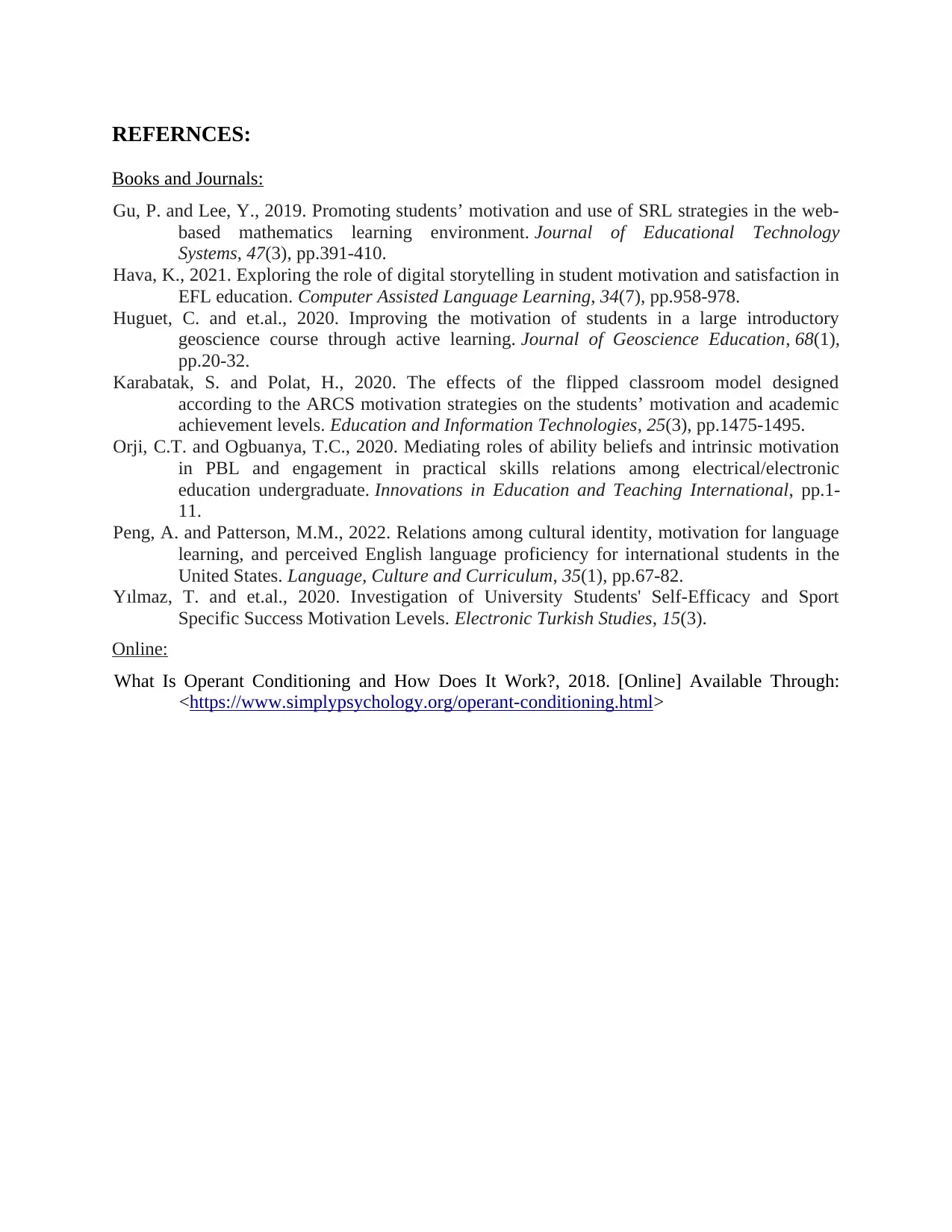
REFERNCES:
Books and Journals:
Gu, P. and Lee, Y., 2019. Promoting students’ motivation and use of SRL strategies in the web-
based mathematics learning environment. Journal of Educational Technology
Systems, 47(3), pp.391-410.
Hava, K., 2021. Exploring the role of digital storytelling in student motivation and satisfaction in
EFL education. Computer Assisted Language Learning, 34(7), pp.958-978.
Huguet, C. and et.al., 2020. Improving the motivation of students in a large introductory
geoscience course through active learning. Journal of Geoscience Education, 68(1),
pp.20-32.
Karabatak, S. and Polat, H., 2020. The effects of the flipped classroom model designed
according to the ARCS motivation strategies on the students’ motivation and academic
achievement levels. Education and Information Technologies, 25(3), pp.1475-1495.
Orji, C.T. and Ogbuanya, T.C., 2020. Mediating roles of ability beliefs and intrinsic motivation
in PBL and engagement in practical skills relations among electrical/electronic
education undergraduate. Innovations in Education and Teaching International, pp.1-
11.
Peng, A. and Patterson, M.M., 2022. Relations among cultural identity, motivation for language
learning, and perceived English language proficiency for international students in the
United States. Language, Culture and Curriculum, 35(1), pp.67-82.
Yılmaz, T. and et.al., 2020. Investigation of University Students' Self-Efficacy and Sport
Specific Success Motivation Levels. Electronic Turkish Studies, 15(3).
Online:
What Is Operant Conditioning and How Does It Work?, 2018. [Online] Available Through:
<https://www.simplypsychology.org/operant-conditioning.html>
Books and Journals:
Gu, P. and Lee, Y., 2019. Promoting students’ motivation and use of SRL strategies in the web-
based mathematics learning environment. Journal of Educational Technology
Systems, 47(3), pp.391-410.
Hava, K., 2021. Exploring the role of digital storytelling in student motivation and satisfaction in
EFL education. Computer Assisted Language Learning, 34(7), pp.958-978.
Huguet, C. and et.al., 2020. Improving the motivation of students in a large introductory
geoscience course through active learning. Journal of Geoscience Education, 68(1),
pp.20-32.
Karabatak, S. and Polat, H., 2020. The effects of the flipped classroom model designed
according to the ARCS motivation strategies on the students’ motivation and academic
achievement levels. Education and Information Technologies, 25(3), pp.1475-1495.
Orji, C.T. and Ogbuanya, T.C., 2020. Mediating roles of ability beliefs and intrinsic motivation
in PBL and engagement in practical skills relations among electrical/electronic
education undergraduate. Innovations in Education and Teaching International, pp.1-
11.
Peng, A. and Patterson, M.M., 2022. Relations among cultural identity, motivation for language
learning, and perceived English language proficiency for international students in the
United States. Language, Culture and Curriculum, 35(1), pp.67-82.
Yılmaz, T. and et.al., 2020. Investigation of University Students' Self-Efficacy and Sport
Specific Success Motivation Levels. Electronic Turkish Studies, 15(3).
Online:
What Is Operant Conditioning and How Does It Work?, 2018. [Online] Available Through:
<https://www.simplypsychology.org/operant-conditioning.html>
1 out of 7
Related Documents
Your All-in-One AI-Powered Toolkit for Academic Success.
+13062052269
info@desklib.com
Available 24*7 on WhatsApp / Email
![[object Object]](/_next/static/media/star-bottom.7253800d.svg)
Unlock your academic potential
Copyright © 2020–2025 A2Z Services. All Rights Reserved. Developed and managed by ZUCOL.





